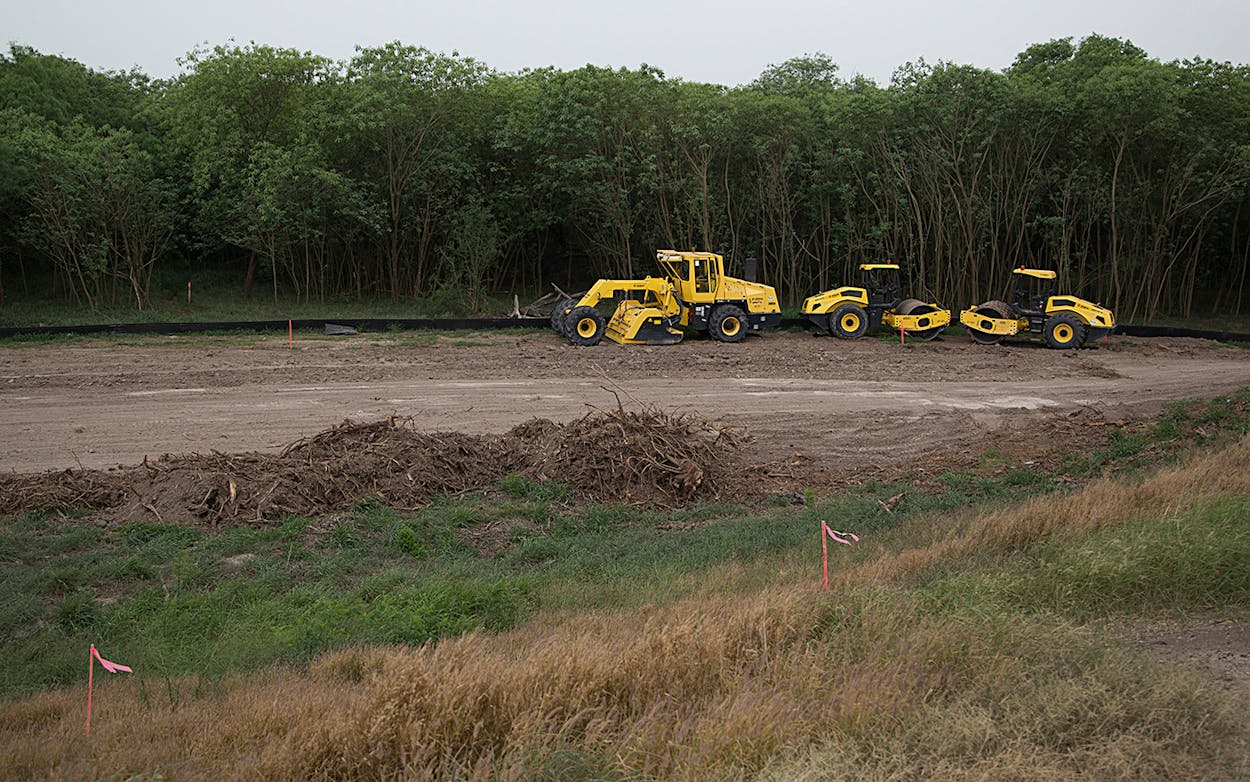At the request of the Trump administration, a federal judge ordered a halt to the construction of a private border wall in South Texas on Thursday. Ruling that the federal government will likely prevail in its lawsuit against the wall’s Trump-supporting backers, U.S. district judge Randy Crane instructed We Build the Wall and its contractor, Fisher Industries, to immediately stop work on a three-and-a-half-mile segment of wall along the banks of the Rio Grande near Mission in the Rio Grande Valley.
The injunction comes in response to an eleven-page lawsuit filed on behalf of the International Boundary and Water Commission, the binational agency that oversees the Rio Grande. The lawsuit states that We Build the Wall and Fisher haven’t submitted complete hydraulic studies proving that the wall wouldn’t worsen flooding on the river, violating international treaty obligations with Mexico.
“The documents submitted contained very little substance and failed to show the extent of any hydraulic testing that may have been conducted by WBTW or Fisher Industries,” the lawsuit said. “This documentation provided scant detail about the planned work on the bank of the Rio Grande.”
According to the lawsuit, despite promising the agency that construction on the wall wouldn’t happen until the studies had been completed, crews have continued to clear vegetation and prep rebar. And on Tuesday, the group announced on its website, “The wall is going up this week no matter what, we will not stop until it’s finished.”
Crane’s order represents a second legal setback this week for We Build the Wall, whose founder has praised President Trump as having “followed through on just about every promise so far.” He added, “this wall project needs to be completed still.” On Tuesday, state district judge Keno Vasquez issued his own restraining order against We Build the Wall, in connection with a lawsuit filed by the National Butterfly Center, a hundred-acre nature sanctuary adjacent to the We Build the Wall site. Vasquez ordered the group to stop construction because the National Butterfly Center faced “imminent and irreparable harm.”
The suit targets We Build the Wall; its leader, Brian Kolfage; and Neuhaus & Sons, the owners of the land where the wall is slated to go.
We Build the Wall did not immediately respond to an email asking for comment. But in an email to the Washington Post on Wednesday, Kolfage seemed to dismiss the legal setback. “We have many people who try to stop us legally with silly attempts, and in the end we always prevail,” Kolfage wrote. “I would put a 50/50 chance this is fake news, and if it’s not it will be crushed legally pretty fast.”
The National Butterfly Center’s lawsuit contends the private wall will act as a dam, causing river water and debris to back up onto its property during flooding. The butterfly center represents some of the last remaining intact riparian environment in the Valley; the monarch butterfly frequents the sanctuary during its annual migration to Mexico. The preserve was deemed significant enough that Congress specifically issued a prohibition of any wall construction on the butterfly center’s property when it provided funding for President Trump’s wall in the last fiscal year.
The butterfly center has also become a rhetorical target of We Build the Wall, which the lawsuit alleges is engaged in a “divide and profit” scheme aimed at scapegoating the conservation center to inflame passions and raise money. Kolfage and his group have also targeted a beloved Catholic priest who has been outspoken against any wall construction, and the head of the butterfly center, Marianna Treviño-Wright, who is also a plaintiff in the case.
“Defendants have falsely claimed that the Catholic Church, Plaintiff Butterfly Center, and Plaintiff Wright are engaged in ‘human trafficking’ and ‘drug smuggling’ in an attempt to vilify the Plaintiffs and opponents of the Defendants’ efforts in the eyes of would be donors,” the lawsuit alleges.
The lawsuit said that We Build the Wall has moved forward on construction despite the International Boundary and Water Commission’s admonishments. “Defendants refuse to wait for testing and inspections because Defendants plan to be long gone with their donors’ money before plans can be vetted,” the fourteen-page lawsuit said. “Defendants plan to move on to other locales to fleece more people of more money leaving the Plaintiffs and other local landowners to suffer as a result of their negligence. “
- More About:
- Politics & Policy
- Border Wall
- Donald Trump
- Mission






